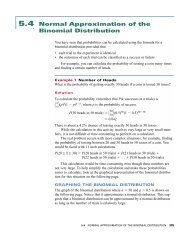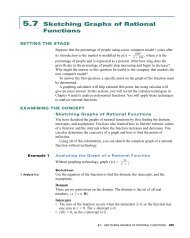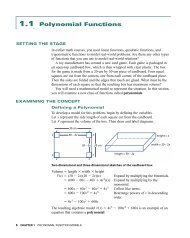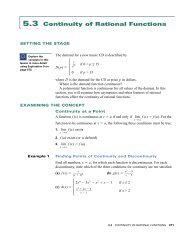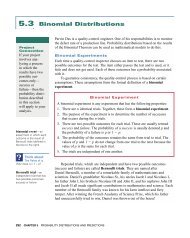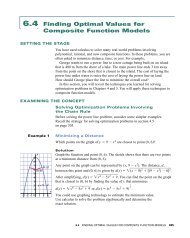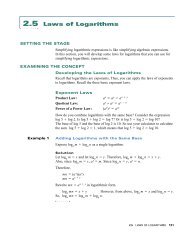1.3 Creating New Polynomial Functions: An Introduction to ...
1.3 Creating New Polynomial Functions: An Introduction to ...
1.3 Creating New Polynomial Functions: An Introduction to ...
You also want an ePaper? Increase the reach of your titles
YUMPU automatically turns print PDFs into web optimized ePapers that Google loves.
Example 1<br />
Subtracting Two <strong>Polynomial</strong> <strong>Functions</strong><br />
Let f (x) 2(x 1)(x 2)(x 4) and g(x) (x 1)(x 2)(x 4).<br />
(a) On the same axes, sketch the graph of each function. Use intercepts, the<br />
degree of the function, and the leading coefficient <strong>to</strong> develop the sketch.<br />
(b) Graph h(x) f (x) g(x).<br />
(c) Identify the domain of each function.<br />
9<br />
6<br />
3<br />
–3 –2 –1<br />
–3<br />
–6<br />
–9<br />
–12<br />
–15<br />
–18<br />
y<br />
Solution<br />
y = g(x)<br />
x<br />
1 2 3 4 5 6<br />
y = f(x)<br />
(a) The zeros for both f (x) and g(x) are 1, 2, and 4.<br />
By inspection, both functions are degree-3 polynomials.<br />
The leading coefficient of f (x) is negative.<br />
Therefore, as x → ∞, f (x) →∞and as x →∞, f (x) → ∞.<br />
For g(x), the leading coefficient is positive.<br />
Therefore, as x → ∞, g(x) → ∞ and as x →∞, g(x) →∞.<br />
The y-intercept of g(x) is 8 and the y-intercept of f (x) is 16.<br />
Using this information results in the sketch <strong>to</strong> the left.<br />
y<br />
12<br />
y = h(x)<br />
8<br />
y = g(x)<br />
4<br />
x<br />
–3 –2 –1<br />
–4<br />
–8<br />
–12<br />
1 2 3 4 5 6<br />
–16<br />
–20<br />
y = f(x)<br />
–24<br />
–28<br />
–32<br />
f (x), g(x), and h(x) f (x) g(x)<br />
(b) h(x) f (x) g(x)<br />
To find points that lie on h(x), subtract the y-coordinates of points<br />
that have the same x-coordinate. The difference function has the<br />
same zeros as the two original functions, that is, 1, 2, and 4.<br />
Subtracting the y-intercepts results in point (0, 24). Create a table<br />
<strong>to</strong> record some additional key points on f and g, and use these <strong>to</strong><br />
find more points on h.<br />
x f (x) g(x) h(x) f (x) g(x)<br />
1 12 6 12 6 18<br />
3 8 4 8 (4) 12<br />
5 36 18 36 18 54<br />
(c) Since f (x) and g(x) are polynomial functions, their domains are the same,<br />
that is, the set of real numbers. The difference function h(x) is also a<br />
polynomial function, and its domain is also the set of real numbers.<br />
For any two functions, the y-values can only be added or subtracted when<br />
the x-values are common. For any polynomial function, the domain is the set<br />
of real numbers, so the difference, or sum, function will have the same<br />
domain, the set of real numbers. However, the range of f (x) ± g(x) must be<br />
determined each time.<br />
<strong>1.3</strong> CREATING NEW POLYNOMIAL FUNCTIONS: AN INTRODUCTION TO COMPOSITION 29



